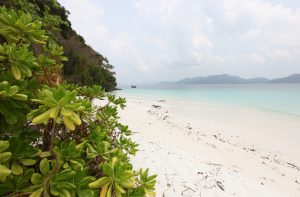 The Mergui Archipelago’s Lampi Marine National Park
The Mergui Archipelago’s Lampi Marine National Park
Lampi Marine National Park offers a diverse range of wildlife that is home to a multitude of indigenous land animals, including: monitor lizards, pythons, civet cats, gibbons, macaques and the near extinct pangolin. Up in the air, the diversity of our natural world is even more noticeable, with endemic hornbills, white-bellied sea eagles, kites, kingfishers, eastern-reef herons and emerald doves to name a few. The Mergui Archipelago waters also showcase an incredible variety of marine life, including: whale sharks and dolphins, as well as manta rays, frogfish, ribbon eels and false pipefish.
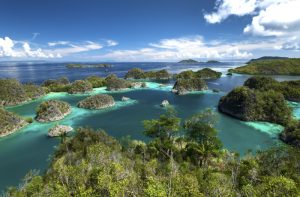 Raja Ampat in Indonesia
Raja Ampat in Indonesia
Raja Ampat, or the ‘Four Kings’, is an archipelago comprising over 1,500 small islands, cays, and shoals surrounding the four main islands of Misool, Salawa , Batanta, and Waigeo. In addition, it is the part of the Coral Triangle which contains the richest marine biodiversity on earth.
Multisport options: An unforgettable experience with sun-drenched mornings and cool tropical evenings spent exploring one of the world’s most famous island groups. Venture into the assembly of over 1,500 small islands, crags and shoals found in Raja Ampat. Best known for its amazing diversity of marine life with one of the richest coral reef ecosystems in the world, many sources rank Raja Ampat as one of the best diving sites in the world. The area is also ideal for sailing, snorkeling, kayaking, as well as bird-watching. We drop anchor in secluded bays, enjoy beach barbeques on castaway islands and observe nature in all its glory.
Check our Wisesa Cruise package on the Agent Hub.
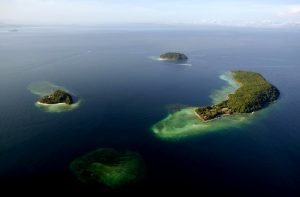 Tunku Abdul Rahman Marine Park
Tunku Abdul Rahman Marine Park
Tunku Abdul Rahman Park is a state park located three kilometers offshore from Kota Kinabalu. Named after Malaysia’s first Prime Minister, Tunku Abdul Rahman, it was promoted in 1974 as Sabah’s second national park. The park covers an area of 50 sq/km, comprising five islands, their surrounding reefs, and sea. Geologically, the islands are part of the Crocker Range but became isolated when sea levels rose after the last ice age.
Mamutik Island forms part of the park and is a favored place for families to partake in a variety of water sports that educate on best practices to protect the fragile ecosystem both above and below the water. Alongside the water activities is plenty of overland action to enjoy too. The Coral Flyer at Kota Kinabalu is an exhilarating flying fox ride over the park, stretching from Gaya Island to Sapi Island. Alternatively head to Kiulu River, just 45 minutes from Kota Kinabalu where it’s possible to try wall climbing, abseiling, white water rafting and jungle trekking.
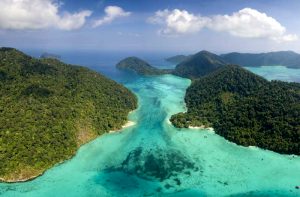 Surin National Marine Park in Southern Thailand
Surin National Marine Park in Southern Thailand
Koh Surin National Marine Park is a paradise of fine white sandy beaches, thick jungle, crystal-clear waters, and the most extensive coral reef in Thailand. The area consists of five islands in total, these are, Koh Surin Nua, Koh Surin Tai, Koh Ri, Koh Kai and Koh Klang.
It is also home to the Moken Sea Nomads. The Moken Sea Nomads are an ancient nomadic sea people who have lived between the Mergui archipelago of Myanmar and the islands of Thailand’s North Andaman coast for thousands of years. The park is a peaceful haven where visitors can connect with Mother Nature under clear blue skies. One advantage of Koh Surin is that scuba diving isn’t essential as the shallow reefs are perfect for snorkeling and bursting with vibrant fish and colorful corals. If you’re lucky, you may even see turtles and whales in the area.
Destination Asia Thailand offers a unique, private tour lead by the indigenous Moken people. After arriving to the islands we immerse in local life with its original inhabitants, learning survival techniques that have remained unchanged for centuries. Please note that Koh Surin National Marine Park is only open from October through May.
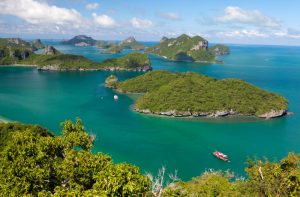 Ang Thong Marine Park
Ang Thong Marine Park
Established as a national marine park in 1980, Mu Ko Ang Thong National Park is a magnificent archipelago of 42 islands covering 102 sq/km off the shoreline of Surat Thai Province in the Gulf of Thailand.
The islands within the park cover an area of 18 sq/km. The highest peak is located on Ko Phaluai at 396 meters above the sea level. The islands themselves consist mainly of rugged and steep limestone hills, sinkholes, caves and inland marine lakes. There is one nomadic village at Ko Wua Ta Lap and one other at Ko Phaluai. The other islands remain uninhabited.
There are few diving sites on the northern islands, though the topography lends itself more to snorkeling. The average depth of the sea is around 10 meters with low visibility due to heavy sediment from the Tapi River. Diving on one of the coral gardens may result in spotting marine species like the green sea turtle, hawksbill sea turtle and yellow-spotted trevallies. The best time for diving is between February and October with optimum visibility around March/April. A spectacular panoramic viewpoint remains one of the top attractions of the park, accessible by a 500m long steep trail. The trail is not for faint-hearted taking roughly 25-30 minutes to ascend using a fixed rope line for support. However, once at the summit, you can enjoy spectacular panoramic views across all the islands.
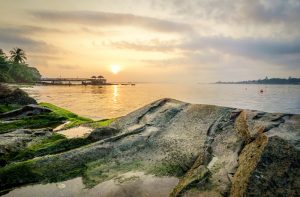 Singapore’s Stunning Islands
Singapore’s Stunning Islands
Venture to the most North Eastern part of Singapore and discover Coney Island. The island’s charm is in how undeveloped it is. Chock-full of skinny tall trees that look more fitting in a Japanese anime
than in Singapore, the island is also home to chickens, otters, monkeys and even a cow roaming in the wild. The island is super huge so don’t be too disappointed if you don’t see them all. Guests still have lots of fun exploring one of the most scenic cycling routes in all of Singapore. And if you have time to spare, why not saddle up and enjoy a short horse ride.
Our Kusu Island tour begins with a short ferry ride from Singapore Marina South Pier to the lush green landscapes of Kusu Island. It’s known by many names such as Tortoise Island and Peak Island. Legend has it that the island came to be when a tortoise flipped itself over to save two sailors of a shipwreck. It’s no wonder then that a visit to the island will bring you face to face with dozens of these majestic and intriguing animals. While exploring Kusu Island, a visit to the Chinese Temple is a must. Also, make a stop by the wishing well or head to the tortoise pond for a relaxing afternoon.
Pulau Ubin is the second largest offshore island of Singapore after Sentosa. Located off the North Eastern end, its geological make up is granite over five smaller islands, interspersed by low-lying mangroves and tidal rivers. It has been a forgotten backyard for many years and finally came onto the radar for redevelopment by the government due to the limited landmass on the Singapore Island.
Be transported back in time to 1960s Singapore as you embark on a trip to nearby Pulau Ubin. Home to Singapore’s last villages or kampongs, the island still retains the rustic beauty and simplicity of a bygone era. Wander along the many trails and see how local residents live with no access to the modern and efficient public utilities on mainland Singapore, they rely on wells for water and depend on traditional farming for subsistence. For those wishing to experience life on this quiet island, a resort is located just off the main village, along one of the bicycle trails.
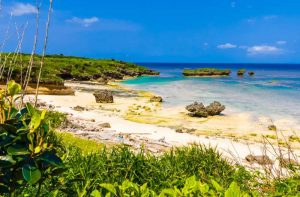 The Galapagos of Japan
The Galapagos of Japan
Iriomote is located at the southernmost tip of Japan. Forming part of the Yaeyama Archipelago in Okinawa and geographically closer to Taiwan than it is to Japan, Iriomote is unlike the rest of the country in that it’s covered in dense jungle. Its isolation from all other land masses has meant that some of the wildlife here is endemic. This has led to the island being referred to as the Galapagos of Japan. Its unique ecosystem and rare animal species led to Iriomote receiving protected national park status in 1972. Today it is known as Iriomote-Ishigaki National Park. Visitors here have the chance to explore rugged hiking trails through the jungle, kayaking through dense mangroves and can also enjoy snorkeling in cobalt coral reef oceans – all on the same day!